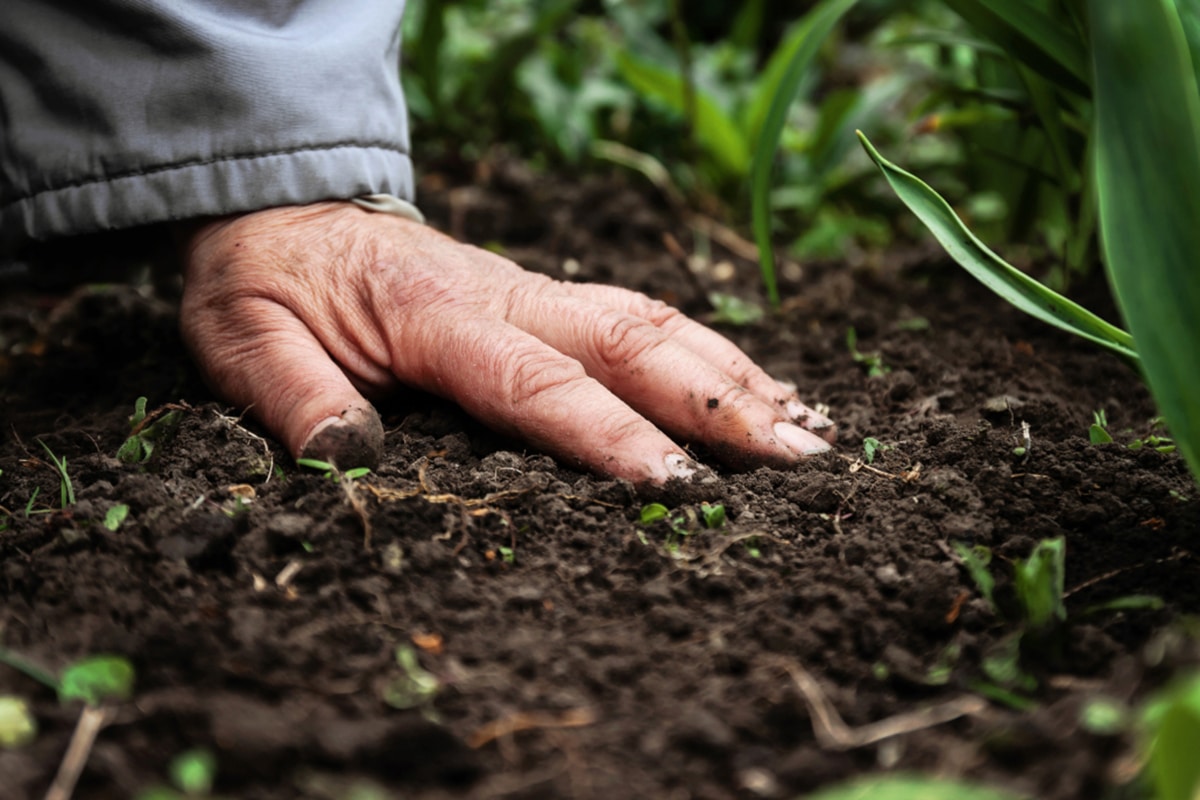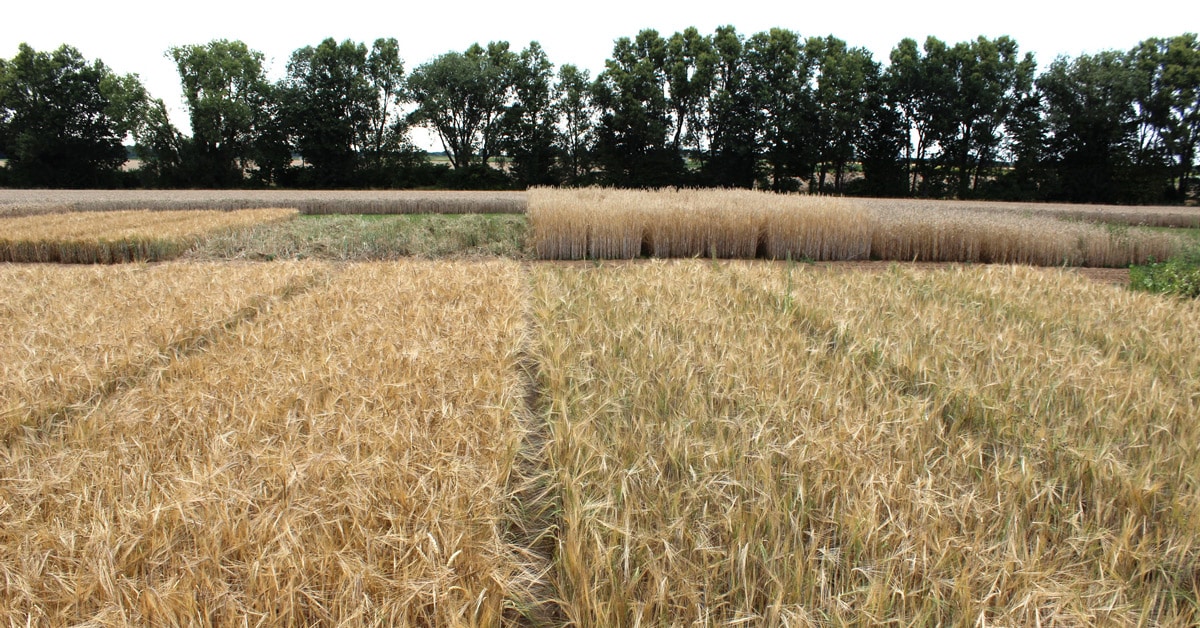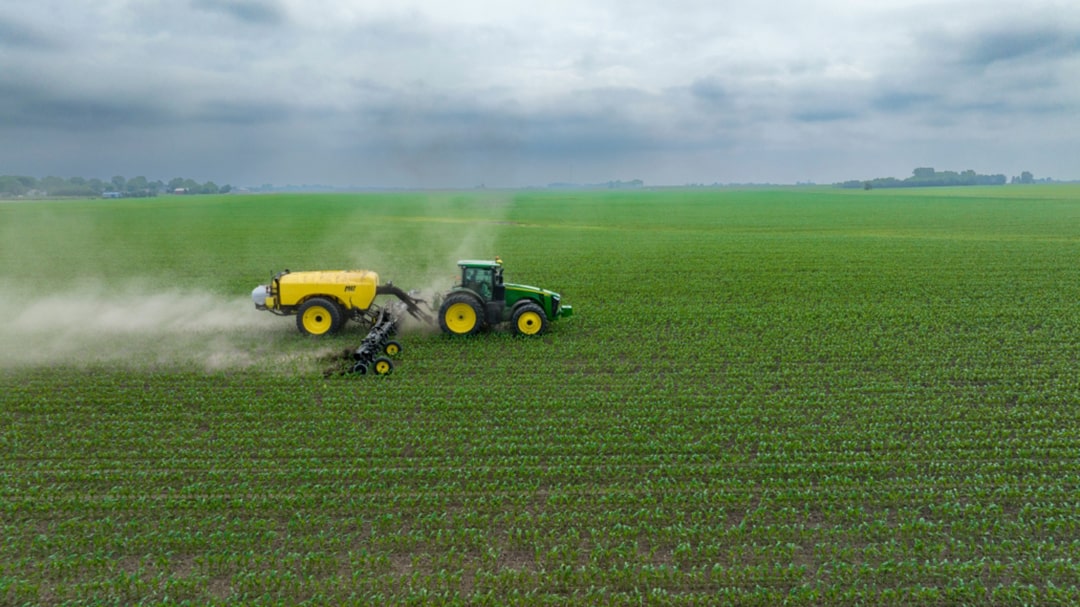

A female old hand on soil-earth. Close-up. Concept of old age-youth life health nature.
Reversing the Loss of Soil Organic Matter – The Elephant in the Room and Solution to Closing the Emissions Gap
by Dr. André Leu, D.Sc., International Director, Regeneration International | Mar 7, 2025
Academics and policymakers make data-free assumptions that most of the increase in CO2 from 278 ppm in 1750 to over 427 ppm in 2024 comes from burning fossil fuels and cement production, with a small proportion from deforestation and nothing from the loss of soil organic matter. 1
According to leading soil scientist Professor Rattan Lal of Ohio State University, soils contain over 2,700 Gt (billion tons) of carbon, the largest terrestrial carbon source 2. This is the climate change debate’s ‘Elephant in the Room’. It defies scientific credibility to ignore a carbon source that is more than double the combined global reserves of 905 Gt of carbon stored in coal, natural gas, and oil and 450 Gt in vegetation.
The Global Carbon Budget, the primary document used by scientists, governments, and the UN, underestimates soil carbon at 1,700 Gt and assumes it does not contribute to CO2 emissions. This is despite the reality that carbon in soils, as soil organic matter (SOM), has been significantly depleted and oxidized into CO2 due to the expansion of industrial agriculture since the Industrial Revolution in 1750. 1,2,3

CAPTION: The Global Carbon Budget underestimates the amount of carbon held in soils and, despite being the largest terrestrial source, incorrectly assumes it does not contribute to CO2 emissions
The oxidation of the carbon in soil organic matter (SOM) caused by excessive tillage, bare soil, erosion, and synthetic nitrogen fertilizers breaks down SOM. It converts it into CO2, significantly increasing atmospheric CO2 levels.
Determining the amount of CO2 resulting from the significant loss of SOM, which began with the rapid expansion of broad-acre agriculture to supply commodities for the Industrial Revolution, is difficult due to limited records of the original SOM levels. Ronnie Cummins and I provide a conservative estimate in “The Regenerative Agriculture Solution” regarding the USA and Australia. At the onset of the Industrial Revolution, both countries had vast areas of uncultivated land that were transformed into some of the first industrial-scale farms. Records of the original SOM levels were available. Based on current average SOM levels, we conservatively estimate that the United States and Australia alone are responsible for 660 Gt of CO2 emissions due to SOM loss. This suggests that thousands of Gt of CO2 have been released from the soil into the atmosphere globally, significantly exceeding the total reserves of fossil fuels. 3
Farming Systems that use Synthetic Nitrogen Fertilizers
Researchers analyzed the SOM levels of a 50-year agricultural trial in Illinois. They discovered that the use of synthetic nitrogen fertilizer led to the complete disappearance of carbon residues from the crops and an average loss of about 10,000 kg of soil organic carbon per hectare (10,000 lbs per acre), which equates to emissions of 36,700 kg of CO2 per hectare (36,700 Lbs per acre). 4,5,6
This loss exceeds the thousands of pounds of crop residue that oxidize into CO2 annually. Multiple studies have shown that the higher the application of synthetic nitrogen fertilizer, the greater the amount of soil organic matter lost as CO2. 4,5,6
A simple back-of-the-envelope calculation (see Appendix) extrapolating this data across 90% of croplands indicates that, conservatively, 51 Gt of CO2 is emitted into the atmosphere each year due to the oxidation of SOM. This source of CO2 surpasses fossil fuel emissions, and it is not accounted for in current models or climate change negotiations.
Grazing Systems and Soil Organic Matter (SOM) Loss
The results are even more striking considering the oxidation of soil organic matter (SOM) from the 3.4 billion hectares of rangelands and permanent pastures, which account for 68% of agricultural lands. These areas are experiencing some of the most significant SOM losses, transforming once-fertile, carbon-rich pastures into dustbowl deserts. Many of these regions contained deep, carbon-rich topsoils with 3% to 16% or more soil organic matter. Now, extensive areas have less than one percent. A one percent loss of soil carbon per hectare results in 154 tons of CO2 being released into the atmosphere. Extending this across 3.4 billion hectares, the one percent loss equates to 524 gigatons of CO2. Since most areas have experienced a considerably greater loss of SOM than one percent, the total global emissions from rangelands since 1750 would be significantly higher in the thousands of gigatons. This data indicates a conservative underestimation of loss of 0.10% SOM due to rangeland degradation, which would contribute to 52 Gt CO2 emissions annually.
Landscape Degradation and Emissions
The IUCN estimates that annual emissions from peatlands drained for industrial agriculture total 1.9 Gt of CO2. This figure accounts for 5% of Global Carbon Budget greenhouse gas emissions, which is disproportionate considering that damaged peatlands cover only 0.3% of the Earth’s landmass. For example, in 2015, fires in Indonesian peat swamp forests released nearly 16 million tons of CO2 per day, exceeding the total emissions of the entire United States. 7
The latest research shows that the carbon loss from deforested and drained tropical peatland has been underestimated, with an average loss of 31 tons per hectare annually. This is 113.77 tons of CO2 emission per hectare. 5.1 million hectares of peatland have been deforested for industrial agriculture in Peninsular Malaysia and the islands of Sumatra and Borneo, in the western part of insular Southeast Asia, since 1990. These alone contribute 580 million tons of CO2 emissions annually. They are the tip of the iceberg. 8, 9
According to the United Nations Convention to Combat Desertification (UNCCD), humans have already altered 70 percent of all ice-free land, and current agricultural practices erode soils worldwide up to 100 times faster than natural processes can replenish them. These eroded and degraded soil oxidize soil carbon into CO2. 10
Annual CO2 emissions of 52 Gt from rangeland degradation and 51 Gt from croplands are conservative and realistic assumptions. Overlooking potential annual emissions exceeding 100 Gt of CO2 from rangeland and croplands demonstrates that current climate models are flawed. These emissions are significantly more than the 36 Gt from fossil fuels and cement, partly explaining the consistent failures in implementing solutions to mitigate the effects of climate change over the last 40 years and why these failures will continue.

CAPTION: Current climate change models completely ignore CO2 emissions from the loss of soil organic matter, even though soil is the largest terrestrial carbon source. Research shows that the degradation caused by industrial agriculture emits more than 100 Gt—three times the amount of fossil fuel emissions.
A study published by Skrable, Chabot, and French analyzed changes in the proportions of carbon-14 (C-14) in the atmosphere and disproved the idea that the increase in CO2 is primarily due to the burning of fossil fuels. This study has been criticized by those who argue that climate change is caused solely by fossil fuels; however, it has undergone peer review, and its methodology and conclusions are valid.
All living organisms absorb C-14. It decays over time and disappears after 45,000 years. Its decay rate is used to date artifacts in archeology, paleontology, and many other sciences. Fossil fuels are so old that they do not have C-14. Consequently, the authors of this study could use it to determine the percentage of fossil fuel-based CO2 in the air from the beginning of the Industrial Revolution. 11
“Our results show that the percentage of the total CO2 due to the use of fossil fuels from 1750 to 2018 increased from 0 percent in 1750 to 12 percent in 2018, much too low to be the cause of global warming,”.
The research indicates that a significant portion of the increase in atmospheric CO2 since 1750, from 280 ppm to over 400 ppm, originates from living carbon sources rather than fossil fuels. These sources are primarily due to deforestation and the loss of soil organic matter (SOM). Since 1750, the start of the Industrial Revolution, 1.5 billion hectares (3.7 billion acres) of forest have been cleared, an area 1.5 times larger than the United States. This deforestation has contributed, and continues to contribute, substantially to current CO2 levels. These forests played a crucial role in absorbing CO2 through photosynthesis. Not only has this capacity for removal been diminished, but all the biomass has been oxidized into CO2 and released back into the atmosphere. Clearing these ecosystems also leads to significant SOM losses that are oxidized into CO2. 3

The Emissions Gap
Most human-generated CO2 is produced in the northern hemisphere; however, the oceans and forests of the southern hemisphere act as sinks for it. As CO2 diffuses throughout the atmosphere, levels decrease because the oceans and plants can absorb it. The average CO2 level recorded at Mauna Loa in Hawaii for January 2025 in the northern hemisphere was 426.65 ppm.12 The CO2 levels recorded at Cape Grim in Tasmania, in the southern hemisphere, for January 2025, were 421.58 ppm.13 This reduction of 5.07 ppm corresponds to 39 Gt of CO2 being removed from the atmosphere. The vast majority of CO2 emissions are removed through photosynthesis by land plants and blue-green algae in the oceans.

CAPTION: In January 2025, the levels of CO2 decreased from 426.65 ppm at Mauna Loa in Hawaii to 421.58 ppm at Cape Grim in Tasmania. This reduction of 5.07 ppm corresponds to 39 Gt of CO2 being removed from the atmosphere, primarily through photosynthesis by plants and algae. This is more than the total amount of fossil fuel emissions of 36 Gt.
The critical issue is ending the emissions gap between Earth’s natural systems’ ability to remove CO2 and anthropogenic emissions. The gap recorded at Cape Grim from January 2024, 417.97, to January 2025, 421.58, is 3.61 ppm, meaning atmospheric CO2 increased by 28 Gt.
For the past forty years, efforts to close this gap by reducing fossil fuel consumption and increasing the use of renewable energy have failed. Many countries, including India, China, and now the USA, are actively increasing their fossil fuel production and consumption to meet the energy demands of economic growth. Little is expected to change in these activities for decades, if ever. The minor decreases in European emissions are merely a ripple effect, incurred at significant economic and severe environmental costs due to the industrialization of their rural landscapes for renewable energy. The gap in CO2 emissions continues to widen each year, and there is no realistic chance of achieving the elusive net-zero emissions by 2050 under this scenario.
Closing the Emissions Gap
Implementing easy-to-adopt regenerative agricultural practices like cover crops and rotational grazing to prevent 100 Gt of CO2 emissions from rangelands and croplands will swiftly close the emissions gap, begin sequestering excess atmospheric CO2 into the soil, and restore the climate.
Implementing regenerative agriculture can reverse climate change by eliminating CO2 emissions from SOM loss caused by industrial agriculture. Regenerative agriculture captures CO2 in the soil and enhances SOM. The key to restoring our planet’s climate lies in removing the primary source of CO2 and increasing the terrestrial environment’s capacity to absorb it through photosynthesis. This can be accomplished by stopping ecosystem destruction, restoring forests and pastures, and discontinuing synthetic nitrogen fertilizers by replacing them with cover crops. These are easy-to-achieve, shovel-ready solutions. 3, 14
Appendix for Calculations
Conversion Formulas
- For simplicity, the numbers have been rounded off to the nearest decimal.
- There are 2.471054 acres to a hectare. I have rounded this off to 2.5 acres to the hectare, a standard practice.
- Similarly, I have rounded off pounds per acre to kilograms per hectare.
- This article treats Metric and US tons as equivalent.
- A gigaton (Gt) equals one billion tons.
- 3.67 is the conversion of carbon into CO2
- One ppm of CO2 equals 7.76 gigatons (Gt) of CO2
Calculations
These calculations are not intended as scientific proof; rather, these types of back-of-the-envelope analyses are intended to help conceptualize the potential of a strategy or methodology when testing a hypothesis. They are a starting point, not an ending point.
By the same token, calculations of human-caused greenhouse gas emissions should be viewed skeptically, as governments and organizations employ different methodologies and assumptions based on various sources. Estimated figures must always be questioned for their credibility. This is the nature of good science—always question to revise outcomes.
Farming Systems that use Synthetic Nitrogen Fertilizers
The land use figures come from the United Nations Food and Agriculture Organization (UN FAO).
- Arable cropland: 1,396,374,300 hectares (3,490,935,750 acres)
- Permanent crops: 153,733,800 hectares (384,334,500 acres)
Total 1,550,108,100 hectares = 1.55 billion hectares.
The Green Revolution pushed using synthetic nitrogen fertilizers as the primary way to increase crop yields, resulting in about 90% of these farms regularly utilizing them. Less than 1% is under organic production. Khan et al. (2007) showed that adding nitrogen fertilizer caused soil carbon loss, producing 36.7 tons of CO2 emissions per hectare.
A simple formula to calculate the soil carbon emission from this sector is 90% of 1.55 billion hectares multiplied by 36.7 tons of CO2 per hectare equals 51 Gt of CO2 emissions annually.
This means a conservative estimate of 51 billion tons (Gt) of CO2 are emitted into the atmosphere yearly by industrial agriculture’s oxidation of soil organic matter. This large source of CO2 is not accounted for in the models or climate change negotiations.
Grazing Systems and Soil Organic Matter (SOM) Loss
The UN FAO has estimated that grazing occurs on 3,358,567,600 hectares of rangelands and permanent pastures (8,396,419,000 acres). The United Nations Convention to Combat Desertification (UNCCD) estimates that most of these areas are degraded with moderate to severe soil carbon loss.
Dr. Christine Jones states, “An increase of 1 percent in the level of soil carbon in the 0–30 cm soil profile equates to sequestration of 154 tons CO2/ha with an average bulk density of 1.4 g/cm3.”14
A simple formula to calculate the CO2 emissions from a one percent loss of SOM in this sector is 3.4 billion hectares multiplied by 154 tons of CO2 per hectare equals 524 Gt.
A conservative assumption of a 0.10% annual loss of SOM equals 52 Gt of CO2 emissions annually.
The Emissions Gap
The average CO2 level recorded at Mauna Loa in Hawaii for January 2025 in the northern hemisphere was 426.65 ppm. The CO2 levels recorded at Cape Grim in Tasmania, in the southern hemisphere, for January 2025, were 421.58 ppm. Using the accepted formula, one ppm of CO2 equals 7.76 gigatons (Gt) of CO2; this reduction of 5.07 ppm corresponds to 39 Gt of CO2.
The gap recorded at Cape Grim from January 2024, 417.97, to January 2025, 421.58, is 3.61 ppm. Using the accepted formula, one ppm of CO2 equals 7.76 gigatons (Gt) of CO2, results atmospheric CO2 increased by 28 Gt over Cape Grim.
Subscribe to Regeneration International
References
- Friedlingstein, P., O’Sullivan, M., Jones, M. W., Andrew, R. M., Bakker, D. C. E., Hauck, J., Landschützer, P., Le Quéré, C., Luijkx, I. T., Peters, G. P., Peters, W., Pongratz, J., Schwingshackl, C., Sitch, S., Canadell, J. G., Ciais, P., Jackson, R. B., Alin, S. R., Anthoni, P., Barbero, L., Bates, N. R., Becker, M., Bellouin, N., Decharme, B., Bopp, L., Brasika, I. B. M., Cadule, P., Chamberlain, M. A., Chandra, N., Chau, T.-T.-T., Chevallier, F., Chini, L. P., Cronin, M., Dou, X., Enyo, K., Evans, W., Falk, S., Feely, R. A., Feng, L., Ford, D. J., Gasser, T., Ghattas, J., Gkritzalis, T., Grassi, G., Gregor, L., Gruber, N., Gürses, Ö., Harris, I., Hefner, M., Heinke, J., Houghton, R. A., Hurtt, G. C., Iida, Y., Ilyina, T., Jacobson, A. R., Jain, A., Jarníková, T., Jersild, A., Jiang, F., Jin, Z., Joos, F., Kato, E., Keeling, R. F., Kennedy, D., Klein Goldewijk, K., Knauer, J., Korsbakken, J. I., Körtzinger, A., Lan, X., Lefèvre, N., Li, H., Liu, J., Liu, Z., Ma, L., Marland, G., Mayot, N., McGuire, P. C., McKinley, G. A., Meyer, G., Morgan, E. J., Munro, D. R., Nakaoka, S.-I., Niwa, Y., O’Brien, K. M., Olsen, A., Omar, A. M., Ono, T., Paulsen, M., Pierrot, D., Pocock, K., Poulter, B., Powis, C. M., Rehder, G., Resplandy, L., Robertson, E., Rödenbeck, C., Rosan, T. M., Schwinger, J., Séférian, R., Smallman, T. L., Smith, S. M., Sospedra-Alfonso, R., Sun, Q., Sutton, A. J., Sweeney, C., Takao, S., Tans, P. P., Tian, H., Tilbrook, B., Tsujino, H., Tubiello, F., van der Werf, G. R., van Ooijen, E., Wanninkhof, R., Watanabe, M., Wimart-Rousseau, C., Yang, D., Yang, X., Yuan, W., Yue, X., Zaehle, S., Zeng, J., and Zheng, B.: Global Carbon Budget 2023, Earth Syst. Sci. Data, 15, 5301–5369
- Lal R (2008). Sequestration of atmospheric CO2 in global carbon pools. Energy and Environmental Science, 1: 86–100.
- Ronnie Cummins and André Leu, The Regenerative Agriculture Solution: A Revolutionary Approach to Building Soil, Creating Climate Resilience and Supporting Human and Planetary Health, Chelsea Green, September 2024
- Khan, S.A., R.L. Mulvaney, T.R. Ellsworth, and C.W. Boast. 2007. The myth of nitrogen fertilization for soil carbon sequestration. Journal of Environmental Quality 36:1821-1832.
- Mulvaney, R.L., S.A., Khan, and T.R. Ellsworth. 2009. Synthetic nitrogen fertilizers deplete soil nitrogen: A global dilemma for sustainable cereal production. Journal of Environmental Quality 38:2295-2314.
- Man, M., B. Deen, K.E. Dunfield, C.Wagner-Riddle, and M.J. Simpson. 2021.Altered soil organic matter composition and degradation after a decade of nitrogen fertilization in a temperate agroecosystem. Agriculture, Ecosystems & Environment 310:107305.
- https://iucn.org/resources/issues-brief/peatlands-and-climate-change#:~:text=Peatlands%20are%20the%20largest%20natural,global%20anthropogenic%20CO2%20emissions. (Accessed March 3, 2025)
- Gusti Z. Anshari, Evi Gusmayanti, M. Afifudin, Monika Ruwaimana, Lauren Hendricks, Daniel G. Gavin, Carbon loss from a deforested and drained tropical peatland over four years as assessed from peat stratigraphy,CATENA, Volume 208,2022,105719,ISSN 0341-8162,https://doi.org/10.1016/j.catena.2021.105719.
- Miettinen, J. and Liew, S.C. (2010), Degradation and development of peatlands in Peninsular Malaysia and in the islands of Sumatra and Borneo since 1990. Land Degrad. Dev., 21: 285-296. https://doi.org/10.1002/ldr.976
- https://www.unccd.int/land-and-life/land-degradation-neutrality/overview (Accessed March 2, 2025)
- Kenneth Skrable, George Chabot, and Clayton French, World Atmospheric CO2, Its 14C Specific Activity, Non-fossil Component, Anthropogenic Fossil Component, and Emissions (1750–2018), Health Physics 122,no. 2 (February 2022): 291–305,
- https://gml.noaa.gov/ccgg/trends/mlo.html (Accessed March 5,2025)
- https://capegrim.csiro.au/GreenhouseGas/data/CapeGrim_CO2_data_download.txt (Accessed March 5, 2025)
- Leu André, GROWING LIFE, REGENERATING FARMING AND RANCHING, Acres USA, Greeley Colorado, USA, December 2021





